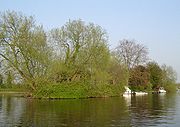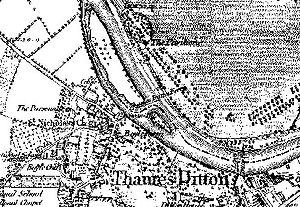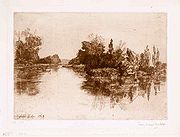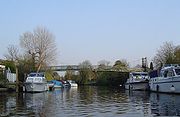
Thames Ditton Island
Encyclopedia

River Thames
The River Thames flows through southern England. It is the longest river entirely in England and the second longest in the United Kingdom. While it is best known because its lower reaches flow through central London, the river flows alongside several other towns and cities, including Oxford,...
near Thames Ditton
Thames Ditton
Thames Ditton is a village in Surrey, England, bordering Greater London. It is situated 12.2 miles south-west of Charing Cross between the towns of Kingston upon Thames, Surbiton, Esher and East Molesey...
, Surrey
Surrey
Surrey is a county in the South East of England and is one of the Home Counties. The county borders Greater London, Kent, East Sussex, West Sussex, Hampshire and Berkshire. The historic county town is Guildford. Surrey County Council sits at Kingston upon Thames, although this has been part of...
, on the reach above Teddington Lock
Teddington Lock
Teddington Lock is a complex of three locks and a weir on the River Thames in England at Ham in the western suburbs of London. The lock is on the southern Surrey side of the river....
. Thames Ditton Island, the largest of the three, is 350 yards (320 metres) long and has 47 houses and a population of around 100. The second largest, Boyle Farm Island, has a single house. Swan Island, between the two, is the smallest.
History


Thames Ditton
Thames Ditton is a village in Surrey, England, bordering Greater London. It is situated 12.2 miles south-west of Charing Cross between the towns of Kingston upon Thames, Surbiton, Esher and East Molesey...
High Street, over what is now the Slipway and, at low tide, straight through the ford to the other side. With the tide in, the ferryman would take you over for a groat
Groat
Groat or Fuppence is the traditional name of an English silver coin worth four English pence, and also a Scottish coin originally worth fourpence, with later issues being valued at eightpence and one shilling.-Name:...
or two. At that time, the king would be rowed up from Westminster
Westminster
Westminster is an area of central London, within the City of Westminster, England. It lies on the north bank of the River Thames, southwest of the City of London and southwest of Charing Cross...
to his place in the country. The last mile or so would have been on a narrowing, twisting creek, especially at low tide.
To effect a grander arrival, the king had the river dug out straight, thus leaving the islands separated from their home county, Middlesex
Middlesex
Middlesex is one of the historic counties of England and the second smallest by area. The low-lying county contained the wealthy and politically independent City of London on its southern boundary and was dominated by it from a very early time...
. Indeed, the islands were thereafter still treated as being in Middlesex and only moved into Surrey
Surrey
Surrey is a county in the South East of England and is one of the Home Counties. The county borders Greater London, Kent, East Sussex, West Sussex, Hampshire and Berkshire. The historic county town is Guildford. Surrey County Council sits at Kingston upon Thames, although this has been part of...
at the county upheaval in 1972. Before there were locks and weirs to control the levels, Summer Road in Thames Ditton
Thames Ditton
Thames Ditton is a village in Surrey, England, bordering Greater London. It is situated 12.2 miles south-west of Charing Cross between the towns of Kingston upon Thames, Surbiton, Esher and East Molesey...
would flood at most high tides, and be barely passable at all in the winter months, hence its name.
The first wooden bridge over the river at Hampton Court opened in 1753, but there was a toll and the ferries remained -- they were cheaper, and it was quite a way to walk just to reach the bridge from the village. The first, rather rickety, bridge was replaced first by a more substantial timber one, in 1778, and by another, in steel and brick, in 1865; this one lasted until the concrete structure we have today was built in 1933. The Thames locks
Locks on the River Thames
The English River Thames is navigable from Cricklade or Lechlade to the sea, and this part of the river falls 71 metres . There are 45 locks on the river, each with one or more adjacent weirs...
began to appear late in the 18th century, the last to be built being that at 'Moulsey' (today called Molesey, in 1815.
Thames Ditton Island
For many centuries the Island formed part of the lands of the Manor of Imworth (Imber) and was associated with what became Forde's Farm and later Boyle Farm. In a survey of the manor of Imber in 1608 the Island was known as Colly's Eite (Ait or Eyot meaning a small island) and is recorded as '2 acres of pasture'. On the Surrey bank opposite, where the Swan inn was built, the slipway and nearby Wharf provided a useful dock for the passage of goods and people up and down the river. Large sailing barges from the Port of LondonPort of London
The Port of London lies along the banks of the River Thames from London, England to the North Sea. Once the largest port in the world, it is currently the United Kingdom's second largest port, after Grimsby & Immingham...
would moor here to load or unload, their crews and attendant waggoners taking rest and sustenance at the inn.
The Island was then not much more than a muddy hump, but the skiff
Thames skiff
A Thames skiff is a traditional River Thames wooden rowing boat used for the activity of Skiffing. These boats evolved from Thames wherries in the Victorian era to meet a passion for river exploration and leisure outings on the water.-Construction of a skiff:...
s of the day trippers from Kingston
Kingston upon Thames
Kingston upon Thames is the principal settlement of the Royal Borough of Kingston upon Thames in southwest London. It was the ancient market town where Saxon kings were crowned and is now a suburb situated south west of Charing Cross. It is one of the major metropolitan centres identified in the...
would be moored there to allow their occupants to enjoy a riverside picnic. In the early part of the 20th century came the fad for riverside weekend bungalows: the idea spread and a number of holiday chalets were built on the Island. Life there must have been a matter of indoor camping, as there were no facilities of any kind: water and paraffin had to ferried over in cans, and only the smarter sheds had a roof over the earth closet.
As time passed, the attractions of the waterside location drew more and more people, so that by 1930 the whole of the perimeter was covered in wooden bungalows, with the owners' boats moored at the bottom of their gardens. It was the building of the suspension bridge in 1939 that really opened up the Island as a place for permanent occupation.
As well as providing passage on foot, it also carried the water, electricity and gas in, and the sewage effluent back out to the town drains. Originally leased from the island's owner, the publican at the Olde Swan, by 1963 all the houses had passed into freehold ownership and a limited company was formed to take over the bridge and adjacent gardens and to provide maintenance services.
Boyle Farm Island
Boyle Farm Island is the second largest of the three islands. It contains a single house, home to just one family. It is directly opposite the historic mansion of Boyle FarmBoyle Farm
Boyle Farm was the earlier name of the 'Home of Compassion', a mansion on the banks of the River Thames in Thames Ditton, Surrey. The house was built on the site of Forde's Farm by Charlotte Boyle Walsingham in the late 18th century. Although the estate has been sold and divided into expensive...
, which is now known as the Home of Compassion. Whereas its larger partner, Thames Ditton Island, has at times been administratively part of Middlesex
Middlesex
Middlesex is one of the historic counties of England and the second smallest by area. The low-lying county contained the wealthy and politically independent City of London on its southern boundary and was dominated by it from a very early time...
, Boyle Farm Island has always belonged to Surrey
Surrey
Surrey is a county in the South East of England and is one of the Home Counties. The county borders Greater London, Kent, East Sussex, West Sussex, Hampshire and Berkshire. The historic county town is Guildford. Surrey County Council sits at Kingston upon Thames, although this has been part of...
.
Swan Island
Swan island is the smallest of the three islands. On it was once the ferryman's hut, recently restored by the present owner, in which the original incumbent must have passed a meagre life, taking people across the main stream and to and from the Island for a small fee at all times of the day and night.Life on the Island today

David Rowell & Co.
David Rowell & Co. was a company based in Westminster, London that fabricated wrought iron and wire rope, built suspension footbridges, and structural steel frame buildings. They were established in 1855 and closed in 1970.-History:...
that really opened up Thames Ditton Island as a place for permanent occupation. As well as providing passage on foot, it also carried the water, electricity and gas in, and the sewage effluent back out to the town drains. Originally leased from the island's owner, the publican at the Olde Swan, by 1963 all the houses had passed into freehold ownership and a limited company was formed to take over the bridge and adjacent gardens and to provide maintenance services. Each householder has to bear a share of the running costs, of which the principal items are the purchase of water and the regular repainting of the bridge.
Nearly all the dwellings are on stilts, in an attempt to prevent flood damage, but the river has, in times past, risen to cover the island in several feet of water. More recent incursions have merely covered gardens and lawns, the mild annoyance being repaid with the depositing of a rich silt.
The river level has ceased to be of any great concern, as the weir system at Teddington Lock
Teddington Lock
Teddington Lock is a complex of three locks and a weir on the River Thames in England at Ham in the western suburbs of London. The lock is on the southern Surrey side of the river....
and the control system operated by the Environment Agency
Environment Agency
The Environment Agency is a British non-departmental public body of the Department for Environment, Food and Rural Affairs and an Assembly Government Sponsored Body of the Welsh Assembly Government that serves England and Wales.-Purpose:...
at Reading
Reading, Berkshire
Reading is a large town and unitary authority area in England. It is located in the Thames Valley at the confluence of the River Thames and River Kennet, and on both the Great Western Main Line railway and the M4 motorway, some west of London....
control winter spates. River outings at these times have to be curtailed as Father Thames rushes by at a fast walking pace.

